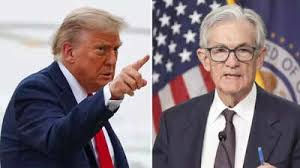
President Donald Trump’s grand declaration at his January inauguration—that “the golden age of America begins right now”—has met a sobering dose of central-bank pragmatism this week. With policymakers at the Federal Reserve opting to hold interest rates steady rather than deliver the deep cuts Mr. Trump has demanded, the chasm between political promise and economic reality has widened. Fed officials, unsettled by the White House’s aggressive tariff agenda and rising inflation projections, have pushed out hopes for easier money until autumn at the earliest, squelching expectations of a swift rebound in consumer borrowing costs.
Tariff Uncertainties and Delayed Rate Cuts
In early April, Mr. Trump rolled out an ambitious plan to levy steep duties on imports from key U.S. trading partners—a move he hailed as essential to protecting American jobs. But the announcement triggered market jitters: bond yields spiked, equity prices wobbled, and economists began warning of a recessionary tilt. Rather than immediate rate relief, the Fed chose at its June 18–19 meeting to keep its benchmark overnight rate at 4.25–4.50%, signaling that any cuts will be gradual and contingent on clearer trade developments.
Federal Reserve Chair Jerome Powell stressed that officials “haven’t yet seen much impact” from existing tariffs, but cautioned that the pause in cuts will remain until after a crucial July 9 deadline. By then, the administration plans to decide whether to impose 50 percent duties on imports from the European Union and similar levies on Canada and Mexico—measures that, if enacted, could deliver a fresh jolt to prices and supply chains. Investors now firmly pencil in a first rate cut in September, though several Fed governors have signaled that no reduction may be warranted if inflation fails to ebb.
At stake is more than just borrowing costs: businesses, stung by erratic trade threats and retaliatory duties, have grown cautious about investment plans, and consumers have shrugged at higher retail prices. A separate analysis by former National Economic Council director Gene Sperling argues that Mr. Trump’s broader assault on independent institutions—from the Fed itself to the Congressional Budget Office—has eroded the bedrock of confidence that underpins long-term economic strength. Without trust in rule-bound policymaking, Sperling warns, the United States risks losing its edge as a stable haven for domestic and foreign capital.
Higher Inflation and Slower Growth Outlook
Just six months ago, Fed projections saw the economy humming along with above-trend growth and inflation steadily marching toward the 2 percent target. Those rosy forecasts have since darkened. Policymakers now expect gross domestic product to expand by a mere 1.4 percent this year—down sharply from a December estimate of 2.1 percent—while unemployment could climb from its current 4.2 percent to as high as 4.5 percent by year’s end, marking the weakest labor market since early 2017.
Inflation, once “grinding down” after its post-pandemic highs, has instead climbed back up. The Fed’s latest dot plot shows officials foreseeing consumer prices rising by roughly 3 percent in 2025, and stubbornly remaining above the 2 percent goal well into 2026. That trajectory pits the Fed at odds with peers in Europe and Asia, many of which continue to ease policy. Mr. Trump, seizing on the recent dip in headline inflation data, has publicly scolded Chair Powell as “stupid” for not slashing rates immediately—an attack that underscores the mounting political pressure on the independent central bank.
The economy’s mixed signals add to the Fed’s dilemma. Friday’s Commerce Department report confirmed a contraction in first‑quarter GDP—the first quarterly decline in three years—driven by weaker consumer spending and disruptions in trade flows. At the same time, the labor market retains an air of resilience: jobless claims remain near multiyear lows, and employers continue to add workers, albeit at a slower pace than in 2024. Yet Powell has flagged an emerging softening in labor demand, warning that if hiring chills further, unemployment could rise swiftly and necessitate a recalibration of monetary policy.
Political Pressure and Institutional Strain
Underpinning the Fed’s cautious stance is the extraordinary political theater surrounding Mr. Trump’s second term. From threats to the Fed’s mandate to high-profile public admonishments of Chair Powell, the White House has displayed little deference to traditional checks on executive power. Such overt politicization of monetary policy has unnerved markets accustomed to the Fed’s insulated decision‑making.
Inside the Fed’s rate‑setting committee, dissent has risen: of the 19 voting members, seven now indicate they see no rate cuts at all in 2025, up from a mere two six months ago. The growing split reflects both genuine concern about rekindled inflation pressures and apprehension that handing Mr. Trump the lower rates he craves would fuel further price gains. In internal deliberations, staff economists have even assessed that a recession is “almost as likely” as the baseline scenario of a mild slowdown—raising the stakes on July’s trade decisions.
Despite these headwinds, the Fed continues to emphasize that its policy framework is data‑dependent. Officials have vowed to remain vigilant on inflation and slack in the labor market, even as trade tensions ebb and flow. Their message is clear: any golden‑age promise must confront the brass‑tacks of economic fundamentals, and until tariffs and price pressures ease, the era of easy money remains on hold.
In the months ahead, markets will watch not only for renewed clarity on tariffs but also for signs that inflation is genuinely cooling. For Mr. Trump, whose political fortunes hinge in part on a buoyant economy, the Fed’s reticence represents a significant hurdle. And for American businesses and households, the coming weeks will reveal whether the central bank’s resolve can tame price pressures without tipping the nation into a downturn—and whether the once‑promised “golden age” will ever materialize.
(Source:www.economictimes.com)
Tariff Uncertainties and Delayed Rate Cuts
In early April, Mr. Trump rolled out an ambitious plan to levy steep duties on imports from key U.S. trading partners—a move he hailed as essential to protecting American jobs. But the announcement triggered market jitters: bond yields spiked, equity prices wobbled, and economists began warning of a recessionary tilt. Rather than immediate rate relief, the Fed chose at its June 18–19 meeting to keep its benchmark overnight rate at 4.25–4.50%, signaling that any cuts will be gradual and contingent on clearer trade developments.
Federal Reserve Chair Jerome Powell stressed that officials “haven’t yet seen much impact” from existing tariffs, but cautioned that the pause in cuts will remain until after a crucial July 9 deadline. By then, the administration plans to decide whether to impose 50 percent duties on imports from the European Union and similar levies on Canada and Mexico—measures that, if enacted, could deliver a fresh jolt to prices and supply chains. Investors now firmly pencil in a first rate cut in September, though several Fed governors have signaled that no reduction may be warranted if inflation fails to ebb.
At stake is more than just borrowing costs: businesses, stung by erratic trade threats and retaliatory duties, have grown cautious about investment plans, and consumers have shrugged at higher retail prices. A separate analysis by former National Economic Council director Gene Sperling argues that Mr. Trump’s broader assault on independent institutions—from the Fed itself to the Congressional Budget Office—has eroded the bedrock of confidence that underpins long-term economic strength. Without trust in rule-bound policymaking, Sperling warns, the United States risks losing its edge as a stable haven for domestic and foreign capital.
Higher Inflation and Slower Growth Outlook
Just six months ago, Fed projections saw the economy humming along with above-trend growth and inflation steadily marching toward the 2 percent target. Those rosy forecasts have since darkened. Policymakers now expect gross domestic product to expand by a mere 1.4 percent this year—down sharply from a December estimate of 2.1 percent—while unemployment could climb from its current 4.2 percent to as high as 4.5 percent by year’s end, marking the weakest labor market since early 2017.
Inflation, once “grinding down” after its post-pandemic highs, has instead climbed back up. The Fed’s latest dot plot shows officials foreseeing consumer prices rising by roughly 3 percent in 2025, and stubbornly remaining above the 2 percent goal well into 2026. That trajectory pits the Fed at odds with peers in Europe and Asia, many of which continue to ease policy. Mr. Trump, seizing on the recent dip in headline inflation data, has publicly scolded Chair Powell as “stupid” for not slashing rates immediately—an attack that underscores the mounting political pressure on the independent central bank.
The economy’s mixed signals add to the Fed’s dilemma. Friday’s Commerce Department report confirmed a contraction in first‑quarter GDP—the first quarterly decline in three years—driven by weaker consumer spending and disruptions in trade flows. At the same time, the labor market retains an air of resilience: jobless claims remain near multiyear lows, and employers continue to add workers, albeit at a slower pace than in 2024. Yet Powell has flagged an emerging softening in labor demand, warning that if hiring chills further, unemployment could rise swiftly and necessitate a recalibration of monetary policy.
Political Pressure and Institutional Strain
Underpinning the Fed’s cautious stance is the extraordinary political theater surrounding Mr. Trump’s second term. From threats to the Fed’s mandate to high-profile public admonishments of Chair Powell, the White House has displayed little deference to traditional checks on executive power. Such overt politicization of monetary policy has unnerved markets accustomed to the Fed’s insulated decision‑making.
Inside the Fed’s rate‑setting committee, dissent has risen: of the 19 voting members, seven now indicate they see no rate cuts at all in 2025, up from a mere two six months ago. The growing split reflects both genuine concern about rekindled inflation pressures and apprehension that handing Mr. Trump the lower rates he craves would fuel further price gains. In internal deliberations, staff economists have even assessed that a recession is “almost as likely” as the baseline scenario of a mild slowdown—raising the stakes on July’s trade decisions.
Despite these headwinds, the Fed continues to emphasize that its policy framework is data‑dependent. Officials have vowed to remain vigilant on inflation and slack in the labor market, even as trade tensions ebb and flow. Their message is clear: any golden‑age promise must confront the brass‑tacks of economic fundamentals, and until tariffs and price pressures ease, the era of easy money remains on hold.
In the months ahead, markets will watch not only for renewed clarity on tariffs but also for signs that inflation is genuinely cooling. For Mr. Trump, whose political fortunes hinge in part on a buoyant economy, the Fed’s reticence represents a significant hurdle. And for American businesses and households, the coming weeks will reveal whether the central bank’s resolve can tame price pressures without tipping the nation into a downturn—and whether the once‑promised “golden age” will ever materialize.
(Source:www.economictimes.com)





